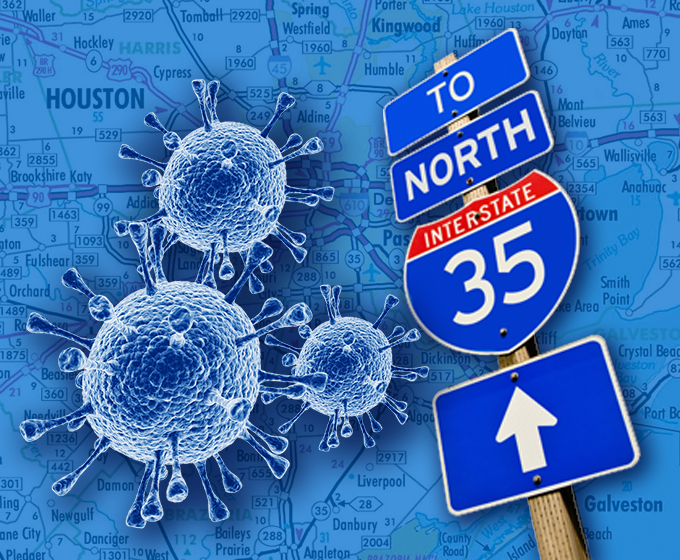
FEBRUARY 11, 2021 — At the beginning of the year, Harris County Judge Lina Hidalgo tweeted about the first confirmed case of the variant B.1.1.7 strand of COVID-19 in Texas coming from her home county.
“This is disturbing,” she wrote about the mutation’s startling nearby appearance. But Richard Jones, a UTSA professor specializing in human geography, was not surprised. He had already predicted that a new variant would enter from Harris County.
Jones had been monitoring the coronavirus since the start of the first wave, in March 2020, when it entered the Lone Star State.
“I started tracing the spread of the coronavirus across Texas from March 6—the index case, in Houston—to early August 2020, predicting the date of the first confirmed case in each county,” Jones said.
Jones uses a spatial diffusion social gravity model (the population of each county divided by the road distance to the metro area to which it is tributary) and local proxies for the county’s connectivity to the outside world to predict this date.
The model is able to explain more than two-thirds of the variation in time-sequencing of the virus as it progressed over five months from the Gulf Coast to the IH-35 corridor and eventually to the Rolling Plains, Edwards Plateau and Trans-Pecos regions of the state.
This approach that addresses a hierarchical and contagious pattern of spread was inspired by the 1989 research of medical geographers Gary Shannon and Gerald Pyle on the origin and diffusion of the AIDS epidemic. Their work showed how once the virus leapfrogged from Africa and the Caribbean into the U.S., it landed in major metropolitan areas such as New York and Los Angeles. From there it spread contagiously from county to county into the surrounding areas.
More than three decades later medical geography offers an accurate methodology with the leverage of data science and GIS methods to create warning systems for new variants. According to the CDC, the B117 variant has become the leading mutation of the COVID-19 virus. Jones anticipates that medical geography will become more integral in sounding the alarms. With his model, local officials can better plan for the arrival of a future virus once it has entered the state.
“The predominant narrative of COVID-19 emphasizes its unpredictable origins and spread. However, regional level diffusion research by geographers has been able to forecast its spread with some accuracy,” Jones explained. “My research aims to lessen fear and foreboding, and enable preemptive response by local planners, through the application of social science modeling and detailed geographic knowledge on the ground.”Jones’ analysis and model can be applied to other states, and his research demonstrates how UTSA works to solve the grand challenges of today. He has submitted this research to The Social Science Journal and it is currently under review.
UTSA Today is produced by University Communications and Marketing, the official news source of The University of Texas at San Antonio. Send your feedback to news@utsa.edu. Keep up-to-date on UTSA news by visiting UTSA Today. Connect with UTSA online at Facebook, Twitter, Youtube and Instagram.
Move In To COLFA is strongly recommended for new students in COLFA. It gives you the chance to learn about the Student Success Center, campus resources and meet new friends!
Academic Classroom: Lecture Hall (MH 2.01.10,) McKinney Humanities BldgWe invite you to join us for Birds Up! Downtown, an exciting welcome back event designed to connect students with the different departments at the Downtown Campus. Students will have the opportunity to learn about some of the departments on campus, gain access to different resources, and collect some giveaways!
Bill Miller PlazaJoin us for an intimate evening of cocktails, conversation, and culinary inspiration with Pati Jinich, Emmy-nominated chef and James Beard Award-winning author. Enjoy light bites and signature drinks in the warm, modern setting of Mezquite as Pati connects with guests over her passion for Mexican cuisine and storytelling.
Mezquite Restaurant in Pullman Market, 221 Newell Ave., San Antonio 78215From inspired courses to thoughtful pairings and a rich sense of community, the Ven a Comer Signature Dinner is a night of shared meals, shared stories, and unforgettable flavor.
Stable Hall (Pear Brewery), 307 Pearl Pkwy, San Antonio 78215Come and celebrate this year's homecoming at the Downtown Campus with food, games, giveaways, music, and more. We look forward to seeing your Roadrunner Spirit!
Bill Miller PlazaThe University of Texas at San Antonio is dedicated to the advancement of knowledge through research and discovery, teaching and learning, community engagement and public service. As an institution of access and excellence, UTSA embraces multicultural traditions and serves as a center for intellectual and creative resources as well as a catalyst for socioeconomic development and the commercialization of intellectual property - for Texas, the nation and the world.
To be a premier public research university, providing access to educational excellence and preparing citizen leaders for the global environment.
We encourage an environment of dialogue and discovery, where integrity, excellence, respect, collaboration and innovation are fostered.